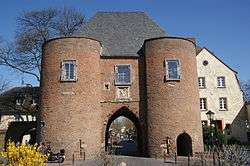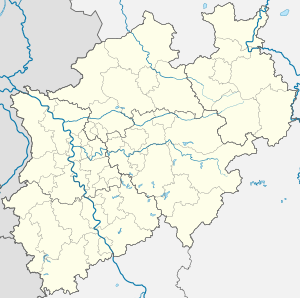Bergheim, North Rhine-Westphalia
Bergheim is a German city 20 km west of Cologne and the capital of the Rhein-Erft-Kreis. The city's Niederaußem district is one of the most important suppliers for energy from lignites in Europe.

Bergheim | |
|---|---|
 "Aachener Tor" Landmark of Bergheim | |
 Coat of arms | |
Location of Bergheim within Rhein-Erft-Kreis district   | |
 Bergheim  Bergheim | |
| Coordinates: 50°58′N 6°39′E | |
| Country | Germany |
| State | North Rhine-Westphalia |
| Admin. region | Köln |
| District | Rhein-Erft-Kreis |
| Subdivisions | 15 |
| Government | |
| • Mayor | Volker Mießeler (CDU) |
| Area | |
| • Total | 96.33 km2 (37.19 sq mi) |
| Elevation | 72 m (236 ft) |
| Population (2018-12-31)[1] | |
| • Total | 61,612 |
| • Density | 640/km2 (1,700/sq mi) |
| Time zone | CET/CEST (UTC+1/+2) |
| Postal codes | 50126, 50127, 50129 |
| Dialling codes | 02271 |
| Vehicle registration | BM |
| Website | Kreisstadt Bergheim (in German) |
Geography
Bergheim is about 20 km west of Cologne, approximately 72 metres above sea level. The highest point is the Glessener Höhe (Glessen Height) at 204 metres. The Erft River flows nearby. The city lies in the Zülpicher Börde, which belongs to the Kölner Bucht. Economically and geographically Bergheim is in the Rhenish lignite coalfield.
History
Dating from about 4000 BC there is a grave hill field in Niederaußem. Around 50 BC the Romans settled in Bergheim. They constructed the major Roman road, the Via Belgica, that crossed the area where Bergheim is today. Later the Franks took control over the region. In the Middle Ages Bergheim was granted city rights and later became part of the County of Jülich. In the 19th and 20th century Bergheim grew rapidly through the settlement of industry based on the local lignite coal. In World War II the Wesseling synthetic oil plant was bombed during the Oil Campaign of World War II. Then in April 1944 a large underground plant for synthetic oil manufactured from lignite was set up outside Bergheim.[2]
Districts
- Ahe
- Auenheim
- Bergheim-Mitte
- Büsdorf
- Fliesteden
- Glesch
- Glessen
- Kenten
- Niederaußem
- Oberaußem
- Paffendorf
- Quadrath-Ichendorf
- Rheidt-Hüchelhoven
- Thorr
- Zieverich
Points of interest
Points of interest are the Niederaussem Power Station with the world's tallest cooling tower as well as the Kottenforst-Ville Nature Park.
Sons and daughters of the city
- Sarah Kreuz (born 1989), singer, second place with DSDS
- Gerhard Fieseler (1896–1987), fighter pilot in the First World War and aircraft constructor (Gerhard-Fieseler-Werke)
- Victoria Ulbrich (born 1992), German singer and former band member of Queensberry
Personalities who have worked here
- Günter Grass (1927–2015): writer, Nobel Prize 1999, after the end of the Second World War he lived in Bergheim-Oberaussem for several years.
- The footballer Lukas Podolski grew up in Bergheim, played in the youth team of FC Jugend 07 Bergheim from 1991 onwards. In 1995 he changed to the D-youth of the 1. FC Köln
- Michael Schumacher (born 1969), Formula 1 racing driver and seven-time world champion, attended the Geschwister-Scholl-Realschule in Bergheim
- Lukas Sinkiewicz (born 1985), German footballer (VfL Bochum, 1.FC Cologne, Bayer 04 Leverkusen)
References
- "Bevölkerung der Gemeinden Nordrhein-Westfalens am 31. Dezember 2018" (in German). Landesbetrieb Information und Technik NRW. Retrieved 10 July 2019.
- "Meeting No. 45/6" (PDF). Enemy Oil Intelligence Committee. February 6, 1945. Archived from the original (pdf) on August 21, 2008. Retrieved 2009-03-22.
| Wikimedia Commons has media related to Bergheim. |
http://www.wiktorp.cku.szkola.pl/Bergheim/Bergheim.htm%5B%5D